Southern Right Whales 101
Southern Right Whales 101
- The southern right whale, Eubalaena australis, is among the largest of the four baleen whale species that come close inshore on the southern African coast: Southern Right, Humpback, Bryde's and Minke whales
- They arrive along the Southern African coasts from May/June and their numbers peak during September/October.
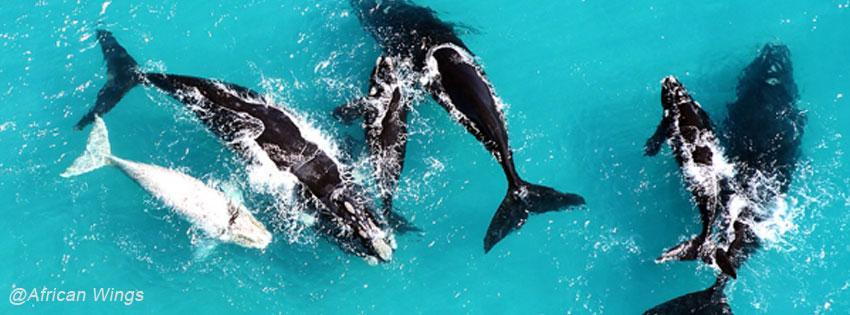
The next generation- calving
- Gestation period is usually 10-12 months
- The calf is born tail first at a rapid pace to allow the new-born to surface and take in air as soon as the umbilical cord breaks.
- The calf measures 5-6m at birth and will suckle on milk for one year
- Females seek out relatively sheltered bays with gently sloping sandy bottoms for calving as they will look for protection from strong winds and currents, as well as predators
- The little calf gets suckled underwater when the mommy ejects the milk into the water close to its mouth, which he/she will then filter out of the water
- The little calf is very thirsty and to grow fast he will drink a few hundred litres of milk per day for the next 4 months.
- The female will remain in our waters for the next 3 months, nursing the calf until it is strong enough to make the long journey to the sub-Antarctic.
- Southern right whales give birth every 3 years
- Calving will take place over a period of four months, peaking in August/September
- Four percent of the calves are born white. These whales will become light grey (brindle) when they become adults.
Some interesting Southern Right Whale info

- Right whales are easily distinguished from other whales by three distinct characteristics:
- V-shaped Blow
- Callosities on their heads
- No dorsal fin on their broad backs
- The very protruding callosity on the upper jaw is referred to as the BONNET – as it resembles the bonnets of a Victorian-era lady.
- The callosities on the jaws are wart-like bumps and are home to specialized whale lice and barnacles.
- Southern right whales can reach a length of 15-17 meters and can weigh 50-60 tonnes.
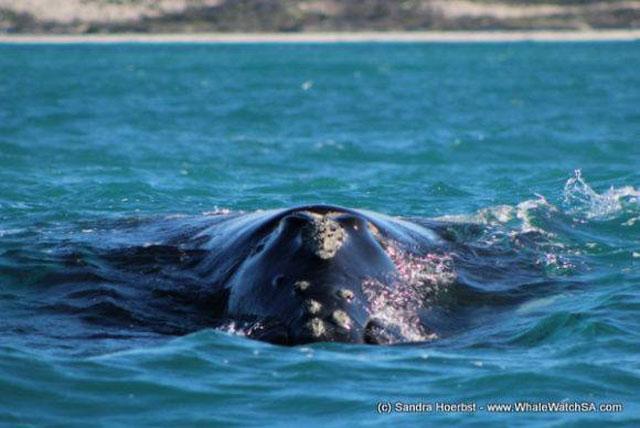
- They have smooth broad backs with no dorsal fin
- They have broad black tails measuring up to 2 m, and large square flippers.
- Their highly arched jaws make them look as if they are always smiling
- Southern right whales will general not feed while visiting our coastal area because our waters do not contain the amount of krill they need- their main food source.
- The krill is filtered out of the water using long baleen plates(i.e. they do not have teeth)
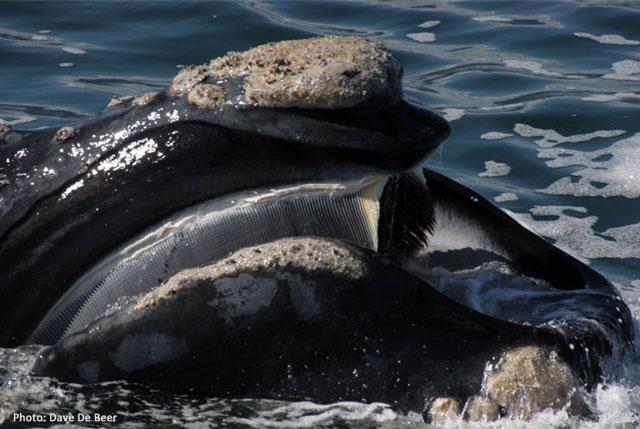
- Southern right whales are individually identified by the callosity pattern on their heads
- Each callosity pattern is unique, similar to our fingerprints
- The data forms part of a digital database of photo-identified whales to share with cetologists and oceanographers globally
Typical whale behaviour:
Breaching:
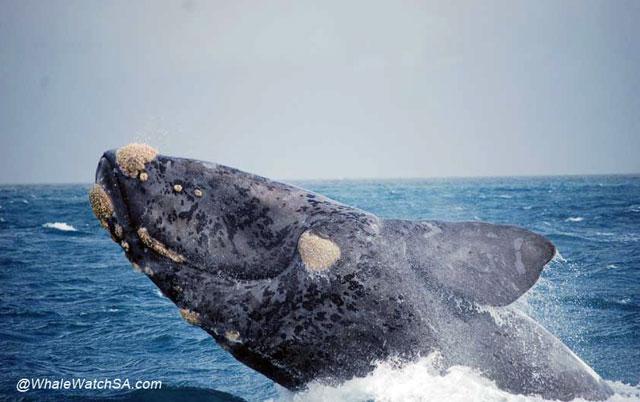
When the whale jumps clear of the water, landing on its back or side with a huge splash. The behaviour might be a to get rid of whale lice, as a sign of aggression, short distance communication or maybe they do it for pure fun!
Lobtailing
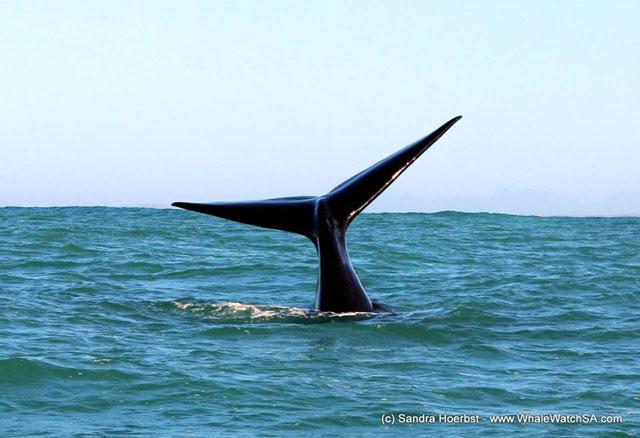
When they repeatedly beat the water with the tail. They might use this behaviour to communicate.
Sailing
When the tail is held aloft for an extended period of time. The behaviour was first noticed by Dr Roger Payne who studied right whales in Patagonia. He noticed that they turn their tails to get the advantage of the wind, much like a sail in the wind.

Spyhopping
The head is held aloft out of the water. It might be that the whale is observing its surroundings as they are most curious.
Why called RIGHT whales?
Old whalers of old named the “right” whales because they were considered the right whale to hunt.
- They are slow swimmers
- They float when they are dead
- They are very curious and will approach the boats making them an easy target to harpoon
- They provide a large amount of oil ( from the enormous blubber)
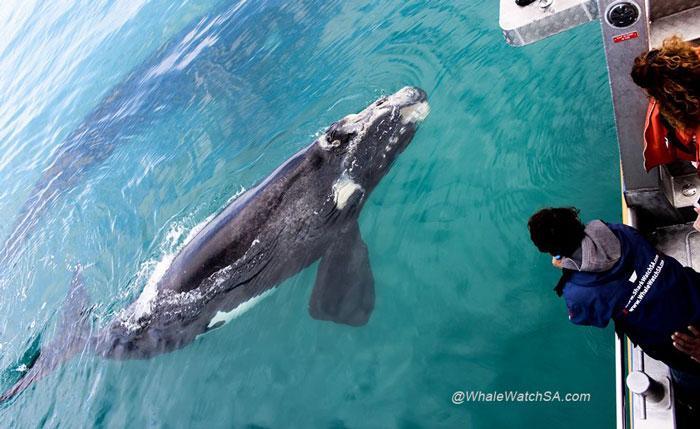
Did you know?
- Whales and dolphins do not sleep like we do. They rest on the surface of the sea or catnap for a few moments while they are swimming. Each side of the brain takes turns to “switch “off while the other half stays vigilant and keeps the animal breathing ( which is voluntary in cetaceans)
- When whales and dolphins open their eyes underwater special greasy tears protect them from stinging salt
- The dorsal fin, a characteristic of most whales, is used to stabilise the animal as it swims through the water.
- The heart of a blue whale is the size of a small car and a small child can stand in arteries leading from the heart.
- Despite the fact that whalers found twin foetuses in approximately 1 % of pregnant females, no reliable cases of twins have been recorded in large whales.
- Bowhead whales have large, unusually thick skulls. They use this to break through ice up to a foot thick in order the breathe. They spend their entire lives in the Arctic waters.
- Despite what many people think, whales and dolphins do not mate for life.
- The only natural predator of a baleen whale is the orca (killer whale) and probably sharks to the very young calves and injured whales

Conservation of Southern Right Whales
- They were granted protection in 1935. Prior to whaling, the total southern hemisphere population exceeded 300 000. Present numbers are up again at about 14,000 individuals, and the population keeps increasing at approximately 7% per year.
- We estimate that about 2000 Southern Right Whales visit South African waters each year.
- The biggest threat to whales relate to human-induced impacts
Boat-Based Whale Watching in Hermanus
Hermanus in South Africa is the Land Based Whale Watching capital of the world and every whale-watching trip is a unique experience where the sightings vary. Southern Right Whales are the stars of the show during the annual mating in calving season, which starts with the arrival of the bulls in June, closely followed by the females. They will mate during their time in the South African Cape Coastal waters. Pregnant female Southern Right Whales will be the last to arrive and the last to leave with their newborn calves. Only when the calves are fit enough will they swim back to the Antarctic waters where she and the calf will feed on krill, a nutritious rice grain size crustacean.
Do you need Accommodation in Hermanus for your Whale Watching trip?
Call us and schedule your listing today! Contact Us
Copyright © 2025 Hermanus Online Magazine. Web Development by Jaydee media.
